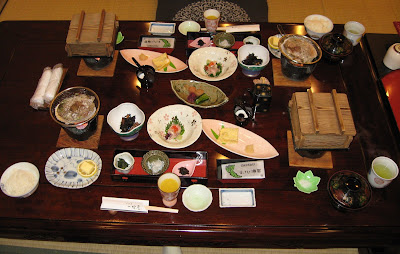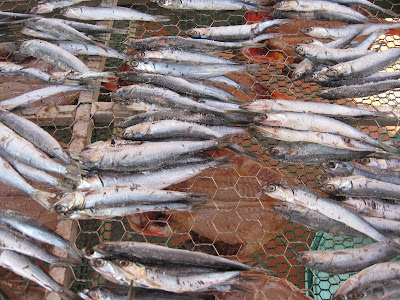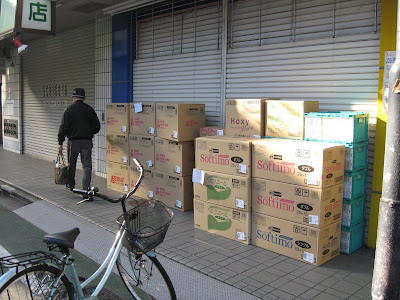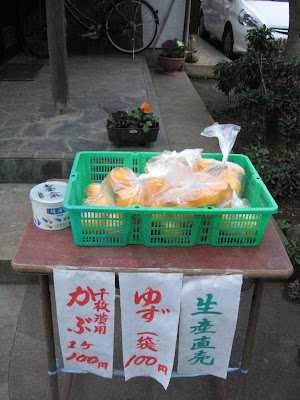To celebrate my work visa, Itsumi treated me to a weekend getaway at a beautiful ryokan, or Japanese traditional inn, in the Kawazu area where we looked at cherry blossoms (see the previous post). The ryokan was beautiful, with several beautiful indoor and outdoor hot springs and traditional tatami-mat rooms, but the best part was the amazing food!

This was our dinner spread, and we were served more dishes even after I took this picture!
 The seating was traditional Japanese style, cushions on a tatami mat floor.
The seating was traditional Japanese style, cushions on a tatami mat floor. This is a beautiful sashimi (raw fish) platter, with four different kinds of fish from the local area, as well as shellfish.
This is a beautiful sashimi (raw fish) platter, with four different kinds of fish from the local area, as well as shellfish. Turban shell shellfish
Turban shell shellfish Clockwise from the lowest point: octopus, shiitake mushrooms, two types of hu (cooked soybean gluten), turnips, show peas, and another type of hu. Center: bamboo shoots.
Clockwise from the lowest point: octopus, shiitake mushrooms, two types of hu (cooked soybean gluten), turnips, show peas, and another type of hu. Center: bamboo shoots. Clockwise from top left: salad dressing, pounded mochi cake flavored with cherry blossom leaves, salad, soymilk tofu, half-cooked egg. The center tray contains small appetizers.
Clockwise from top left: salad dressing, pounded mochi cake flavored with cherry blossom leaves, salad, soymilk tofu, half-cooked egg. The center tray contains small appetizers. At one point I counted 40 vessels on our table, and the server had already taken away some empty bowls at that time. There must have been at least 50 in total.
 In Japan, people really like to cook their own food at their table. I think it's all about the freshness. On the right is shabu shabu, and on the left is a steamed rice dish.
In Japan, people really like to cook their own food at their table. I think it's all about the freshness. On the right is shabu shabu, and on the left is a steamed rice dish.
 Shabu shabu is a dish that involves swishing a piece of raw fish or meat around in a pan of boiling water until it is semi-cooked. Then you dip it in a delicious shabu shabu sauce, and eat it! You can make shabu shabu from fish, beef or pork, but of course you must cook the pork fully. You also boil delicious vegetables in the water. This is fish shabu shabu.
Shabu shabu is a dish that involves swishing a piece of raw fish or meat around in a pan of boiling water until it is semi-cooked. Then you dip it in a delicious shabu shabu sauce, and eat it! You can make shabu shabu from fish, beef or pork, but of course you must cook the pork fully. You also boil delicious vegetables in the water. This is fish shabu shabu.
 This is a fancy dish of soymilk tofu, with salad in the background.
This is a fancy dish of soymilk tofu, with salad in the background.
 The half-cooked egg is a garnish for the salad, along with salad dressing, and it was very good!
The half-cooked egg is a garnish for the salad, along with salad dressing, and it was very good!

 Just when we were almost finished, the server brought us deep fried shrimp croquettes, lotus root and other vegetables, and a gelatin type dessert which was not the actual dessert, just an appetizer dessert.
Just when we were almost finished, the server brought us deep fried shrimp croquettes, lotus root and other vegetables, and a gelatin type dessert which was not the actual dessert, just an appetizer dessert.
 I'm not big on octopus, but Itsumi likes it!
I'm not big on octopus, but Itsumi likes it!
 Clear soup with egg cake and vegetables.
Clear soup with egg cake and vegetables.
 The breakfast spread
The breakfast spread
 In Japan, people really like to cook their own food at their table. I think it's all about the freshness. On the right is shabu shabu, and on the left is a steamed rice dish.
In Japan, people really like to cook their own food at their table. I think it's all about the freshness. On the right is shabu shabu, and on the left is a steamed rice dish. Shabu shabu is a dish that involves swishing a piece of raw fish or meat around in a pan of boiling water until it is semi-cooked. Then you dip it in a delicious shabu shabu sauce, and eat it! You can make shabu shabu from fish, beef or pork, but of course you must cook the pork fully. You also boil delicious vegetables in the water. This is fish shabu shabu.
Shabu shabu is a dish that involves swishing a piece of raw fish or meat around in a pan of boiling water until it is semi-cooked. Then you dip it in a delicious shabu shabu sauce, and eat it! You can make shabu shabu from fish, beef or pork, but of course you must cook the pork fully. You also boil delicious vegetables in the water. This is fish shabu shabu. This is a fancy dish of soymilk tofu, with salad in the background.
This is a fancy dish of soymilk tofu, with salad in the background. The half-cooked egg is a garnish for the salad, along with salad dressing, and it was very good!
The half-cooked egg is a garnish for the salad, along with salad dressing, and it was very good!
 Just when we were almost finished, the server brought us deep fried shrimp croquettes, lotus root and other vegetables, and a gelatin type dessert which was not the actual dessert, just an appetizer dessert.
Just when we were almost finished, the server brought us deep fried shrimp croquettes, lotus root and other vegetables, and a gelatin type dessert which was not the actual dessert, just an appetizer dessert. I'm not big on octopus, but Itsumi likes it!
I'm not big on octopus, but Itsumi likes it! Clear soup with egg cake and vegetables.
Clear soup with egg cake and vegetables.In the morning we had a delicious breakfast, with another huge spread of food! At a ryokan, guests are provided with robes and outfits like the one I'm wearing in the picture, which we can wear as we walk around the ryokan and eat in the dining room.
 The breakfast spread
The breakfast spread


 Fresh scallop, which we ate with butter and lemon.
Fresh scallop, which we ate with butter and lemon. Me in a yukata robe.
Me in a yukata robe.




 another type of dried fish
another type of dried fish




 And above I am walking on a massage walkway made of massaging stones.
And above I am walking on a massage walkway made of massaging stones.



















 Of course, I am always careful about the way I carry money and belongings while traveling, but it's really pleasant to live in a place where I don't have to worry much about crime.
Of course, I am always careful about the way I carry money and belongings while traveling, but it's really pleasant to live in a place where I don't have to worry much about crime.


